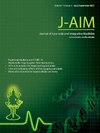小檗和非洲小檗对 2 型糖尿病患者血糖指数和体重状况的疗效:随机对照试验的系统回顾和荟萃分析
IF 1.7
Q3 INTEGRATIVE & COMPLEMENTARY MEDICINE
引用次数: 0
摘要
2 型糖尿病(T2DM)是一种多因素的终身疾病。小檗(BV)和非洲小檗(BI)可调节血糖水平,且不良影响极小。在本系统综述和荟萃分析中,我们评估了 BV 和 BI 与安慰剂相比对血糖指数、体重和体重指数(BMI)的影响。研究的纳入标准为(a) T2DM 患者;(b) 以小檗(庸俗草/integerrima)疗法作为干预措施;(c) 对照组为安慰剂或二甲双胍;(d) 结果包括空腹血糖 (FBG)水平、糖化血红蛋白 (HbA1c%)、胰岛素抵抗静态模型评估 (HOMA-IR)、空腹血清胰岛素 (FSI)、餐后 2 小时血糖 (2hPPG)、果糖胺、体重和体重指数 (BMI); (e) 随机对照试验 (RCT)。数据采用《综述管理器》上的随机效应分析模型进行汇总。采用反方差统计方法,将加权平均差(WMD)作为效果测量指标。科克伦偏倚风险工具对偏倚风险进行了评估。九项研究纳入了 547 名患者。小檗治疗显著降低了FBG(WMD:-14.52;95% CI = -22.97,-6.07;P = 0.0008);HbA1c %(WMD:-0.30;95% CI = -0.53,-0.07;P = 0.01);HOMA-IR(WMD:-0.97;95% CI = -1.56,0.37;P = 0.001)。两组在 2hPPG (WMD:6.52;95% CI = -21.57,34.61;P = 0.65);FSI(WMD:-0.79;95% CI =-1.80,0.22,P = 0.13);果糖胺(WMD:-12.57;95% CI =-40.74,15.60;P = 0.数据显示,FBG 显著降低,胰岛素水平得到改善,但对其他血糖指数的影响有限。要全面了解小檗与 T2DM 之间的关系,还需要在全球范围内开展更广泛的 RCT 研究。本文章由计算机程序翻译,如有差异,请以英文原文为准。
Efficacy of Berberis vulgaris and Berberis integerrima on glycemic indices and weight profile in type 2 diabetic patients: A systematic review and meta-analysis of randomized controlled trials
Type 2 diabetes mellitus (T2DM) is a multifactorial lifelong condition. Berberis vulgaris (BV) and Berberis integerrima (BI) regulate glucose levels with minimal adverse effects. In this systematic review and meta-analysis, we evaluate the effect of BV and BI on glycemic indices, weight, and body mass index (BMI) against placebo.
Four electronic databases were searched till September 24, 2023. Inclusion criteria for studies were: (a) T2DM patients; (b) berberis (vulgaris/integerrima) therapy as intervention; (c) control group of placebo or metformin; (d) outcomes including fasting blood glucose (FBG) levels, glycated hemoglobin (HbA1c%), Homeostatic Model Assessment for Insulin Resistance (HOMA-IR), fasting serum insulin (FSI), 2-h postprandial glucose (2hPPG), fructosamine, weight, and BMI; (e) randomized controlled trials (RCTs). Data was pooled using a random-effects analysis model on Review Manager. The inverse variance statistical method was applied keeping weighted mean difference (WMD) as the effect measure. The Cochrane risk of bias tool evaluated the risk of bias. A p-value of less than 0.05 was considered significant.
Nine RCTs comprising 547 patients were included. Significant reduction was noted with berberis therapy in FBG (WMD: −14.52; 95% CI = −22.97, −6.07; P = 0.0008); HbA1c % (WMD: −0.30; 95% CI = −0.53, −0.07; P = 0.01); HOMA-IR (WMD: −0.97; 95% CI = −1.56, 0.37; P = 0.001). No significant differences were noted between the two groups in 2hPPG (WMD: 6.52; 95% CI = −21.57, 34.61; P = 0.65); FSI (WMD: −0.79; 95% CI = −1.80, 0.22, P = 0.13); Fructosamine (WMD: −12.57; 95% CI = −40.74, 15.60; P = 0.38); Weight (WMD: −1.89; 95% CI = −4.55, 0.76; P = 0.16) and BMI (WMD: −0.12; 95% CI = −0.90, 0.65; P = 0.76).
The data showed significant reduction in FBG and improved insulin levels but limited effects were observed in other glycemic indexes. More extensive RCTs are required globally to achieve a holistic comprehension of the connection between berberis and T2DM.
求助全文
通过发布文献求助,成功后即可免费获取论文全文。
去求助
来源期刊

Journal of Ayurveda and Integrative Medicine
INTEGRATIVE & COMPLEMENTARY MEDICINE-
CiteScore
4.70
自引率
12.50%
发文量
136
审稿时长
30 weeks
 求助内容:
求助内容: 应助结果提醒方式:
应助结果提醒方式:


